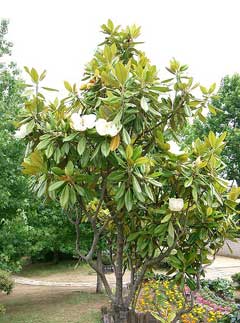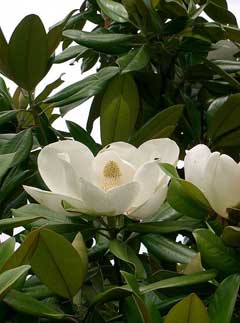 |
|
http://commons.wikimedia.org/wiki/User:KENPEI |
 |
| http://commons.wikimedia.org/wiki/User:KENPEI |
Translate this page:
Summary
Bloom Color: White. Main Bloom Time: Early summer, Early spring, Late summer, Late spring, Mid summer, Mid spring. Form: Oval, Pyramidal.
Physical Characteristics

 Magnolia_grandiflora is an evergreen Tree growing to 10 m (32ft) by 10 m (32ft) at a medium rate.
Magnolia_grandiflora is an evergreen Tree growing to 10 m (32ft) by 10 m (32ft) at a medium rate.
See above for USDA hardiness. It is hardy to UK zone 6. It is in leaf all year, in flower from June to September, and the seeds ripen from September to November. The species is hermaphrodite (has both male and female organs) and is pollinated by Beetles. The plant is not self-fertile.
Suitable for: light (sandy), medium (loamy) and heavy (clay) soils and prefers well-drained soil. Suitable pH: mildly acid, neutral and basic (mildly alkaline) soils. It can grow in semi-shade (light woodland) or no shade. It prefers moist soil. The plant can tolerates strong winds but not maritime exposure.
UK Hardiness Map
US Hardiness Map
Synonyms
M. foetida. M. virginiana foetida.
Plant Habitats
Edible Uses
The flowers are pickled in some parts of England and are considered to have an exquisite flavour[2, 183]. They are also said to be used as a spice and a condiment[183].
References More on Edible Uses
Medicinal Uses
Plants For A Future can not take any responsibility for any adverse effects from the use of plants. Always seek advice from a professional before using a plant medicinally.
The bark is diaphoretic, stimulant, tonic[46, 61, 240]. It is used in the treatment of malaria and rheumatism[240]. A decoction has been used as a wash and a bath for prickly heat itching[257]. The decoction has also been used as a wash for sores and as a steam bath for treating dropsy[257]. An alcoholic extract of the plant reduces the blood pressure, produces a slight acceleration in respiration but has no action on the heart[240].
References More on Medicinal Uses
The Bookshop: Edible Plant Books
Our Latest books on Perennial Plants For Food Forests and Permaculture Gardens in paperback or digital formats.

Edible Tropical Plants
Food Forest Plants for Hotter Conditions: 250+ Plants For Tropical Food Forests & Permaculture Gardens.
More

Edible Temperate Plants
Plants for Your Food Forest: 500 Plants for Temperate Food Forests & Permaculture Gardens.
More

More Books
PFAF have eight books available in paperback and digital formats. Browse the shop for more information.
Shop Now
Other Uses
A fairly wind-tolerant tree, it can be used in shelterbelt plantings[200]. An essential oil is obtained from the flowers[240]. Wood - hard and fairly heavy, but weak and not durable[227]. White when first cut, it turns brown on exposure to air[229]. It is used in limited amounts for fuel, baskets, crates, woodenware and furniture[82, 227].
Special Uses
References More on Other Uses
Cultivation details
Landscape Uses:Espalier, Firewood, Pest tolerant, Aggressive surface roots possible, Screen, Seashore, Specimen, Street tree. Best grown in a warm position in a moderately rich free soil of an open texture[1]. Tolerates moderately limey soils[200, 202] so long as they are deep and rich in humus[188]. The branches are brittle so a sheltered position is required[200]. Another part of the same book says that this species is fairly wind-resistant[200]. Succeeds in full sun or semi-shade[219]. Plants are hardy to about -10°c[200]. The fleshy roots are easily damaged and any transplanting is best done during a spell of mild moist weather in late spring[182]. A very ornamental plant[1], a number of named forms have been developed[200]. The flowers are very large (up to 25cm across) and have a delicious and very powerful scent[202, 245]. This is perhaps the most strongly scented flower in the world[245]. They can be produced in trees as young as 10 years old[229]. The form 'Exmouth Variety' (also known as elliptica) produces its flowers when younger than the species, these flowers have a refreshing lemon scent[245]. There is no main flush of flowering, instead the flowers open intermittently throughout the summer[K]. Plants do not normally need pruning, any cutting out of dead wood etc is best carried out in July[219]. Special Features:
Attracts birds, Attractive foliage, North American native, Fragrant flowers, Attractive flowers or blooms.
References Carbon Farming Information and Carbon Sequestration Information
Temperature Converter
Type a value in the Celsius field to convert the value to Fahrenheit:
Fahrenheit:
The PFAF Bookshop
Plants For A Future have a number of books available in paperback and digital form. Book titles include Edible Plants, Edible Perennials, Edible Trees,Edible Shrubs, Woodland Gardening, and Temperate Food Forest Plants. Our new book is Food Forest Plants For Hotter Conditions (Tropical and Sub-Tropical).
Shop Now
Plant Propagation
Seed - best sown as soon as it is ripe in a cold frame. Stored seed must be kept cold over the winter and should be sown in late winter in a cold frame[200]. The seed usually germinates in the spring but it can take 18 months. Prick out the seedlings into individual pots when they are large enough to handle and grow them on in light shade in a cold frame or greenhouse for at least their first winter. They can be planted out into their permanent positions when they are more than 15cm tall, though should be well mulched and given some protection from winter cold for their first winter or two outdoors. Layering in early spring[200].
Other Names
If available other names are mentioned here
Native Range
NORTHERN AMERICA: United States (Alabama (south), Arkansas, Florida, Georgia, Louisiana, Mississippi (south), North Carolina (east), South Carolina, Texas)
Weed Potential
Right plant wrong place. We are currently updating this section.
Please note that a plant may be invasive in one area but may not in your area so it’s worth checking.
Conservation Status
IUCN Red List of Threatened Plants Status :

Growth: S = slow M = medium F = fast. Soil: L = light (sandy) M = medium H = heavy (clay). pH: A = acid N = neutral B = basic (alkaline). Shade: F = full shade S = semi-shade N = no shade. Moisture: D = dry M = Moist We = wet Wa = water.
Expert comment
Author
L.
Botanical References
1172200
Links / References
For a list of references used on this page please go here
Readers comment